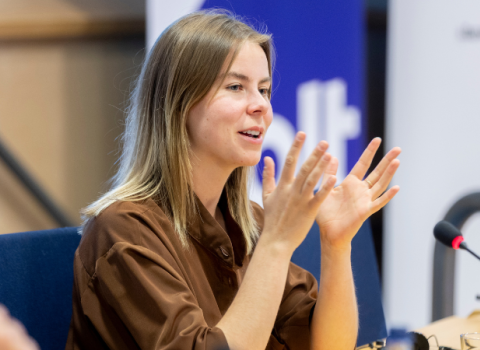By 2045, all electricity in Germany should come from renewable sources. The problem is that wind and solar power do not provide a regular electricity supply, but rather fluctuate. As part of the Kopernikus project SynErgie, the Fraunhofer Institute for Manufacturing Engineering and Automation IPA is working with partners to develop an energy synchronization platform which will allow industry to offset these fluctuations and synchronize production with power generation. The Fraunhofer IPA researchers are also currently developing the first electricity-saving application for the IT platform.
By the middle of the century, Germany should be reaching climate neutrality. However, increased use of renewable energy does lead to a constantly fluctuating electricity supply, due to its reliance on the weather. To ensure that the balance of supply and demand can be guaranteed at all times, measures are needed to offset these fluctuations. Energy-intensive industry processes have a high potential for flexibility, which would counter fluctuation by changing electricity demand. The Kopernikus project SynErgie has brought together more than 90 partners (see information box) and 18 industry and research partners to work together on an energy synchronization platform which will enable different industrial companies to synchronize their energy requirements with the volatile energy supply. In the future, this platform should be able to coordinate supply and demand, automate and standardize the entire process of energy flexibility trading from machine to market through the IT platform and its services, and map it in a reference architecture. The digital services that run on the platform use data from companies’ systems and plants to determine how to use the various flexibility measures available, depending on demand. By the end of 2022, the reference architecture for this should be complete, and will be tested using multiple research and industry demonstrators in the energy-flexible model region of Augsburg. Fraunhofer IPA is coordinating the project alongside the Institute for Energy Efficiency in Production (EEP) at the University of Stuttgart.
“For this project, we are developing flexible production and cross-sectional technologies as well as an IT backbone that will enable companies to flexibly control the energy demand of their plants and use this flexibility profitably on the energy market. To achieve this, we have two focal points: The IT systems with their services, prognosis algorithms and aggregation algorithms, and the various technological solutions needed to synchronize production with electricity generation and to separate process energy consumption from electricity consumption at the grid connection point,” explains Ozan Yesilyurt, IPA scientist.
The energy synchronization platform will address many questions: What is the current amount of electricity on the market? Is there a surplus or shortage? How will electricity prices change? How quick do reactions need to be, and how long do they need to last? Which company can act now to offset this surplus or shortage? An intelligent control system is needed to strike this balance between flexible supply and demand. “The IT platform is aimed at bringing companies together to tackle flexible demand. The Virtual Fort Knox cloud platform, developed at Fraunhofer IPA, serves as the basis for this,” says Yesilyurt, who works in the DigiTools for Manufacturing department at Fraunhofer IPA.
Corporate and market platform
The energy synchronization platform consists of two sub-platforms – a corporate platform and a market platform. The former can record, manage and aggregate the energy flexibility of a company. The aim of this is to inform the companies how they can use their flexibility on the market to buy energy at an affordable price or sell it if they have acquired it already. The market platform, on the other hand, acts as a service broker that ensures that companies requiring flexibility have access to supply. Aggregators can, for example, sign up on the market platform and register their interest in buying or selling flexibility. The market platform then shares company flexibility with flexibility marketers, who then sell this flexibility on the energy market. The energy synchronization platform differentiates itself from energy trading platforms, on which energy flexibility is traded. The new platform offers greater exchange between energy market traders and companies able to offer flexibility.
Reducing electricity prices with autonomous robots
Digital services that regulate the use of energy according to demand and help reduce electricity consumption play a crucial role. Yesilyurt has developed a battery use optimization service to provide this on the corporate platform – it’s currently in testing. The service will help companies to manage peak demand periods: Production companies have high electricity demands, which increase sharply when all machines are in operation. This demand peak can be expensive for operations because electricity providers use this peak value to calculate service prices. When the peak value is exceeded, additional fees are incurred. “Many companies use automated guided vehicles (AGVs) powered by high-capacity lithium-ion batteries. These batteries help to prevent demand peaks. To achieve this, the autonomous robots must only be returned to charging stations when electricity demand increases, and surplus charge can be fed into the company’s own grid. The availability of the AGVs must be determined and coordinated with the peaks so that operations can continue,” explains Yesilyurt. By doing so, operations no longer rely on electricity coming directly from providers, but use the autonomous robot batteries as an energy provision system. This is called bidirectional charging. “This concept has long been used for electric cars, but not for AGVs. What we are doing here is pioneering work. Until now, a comparable software service for production has not existed.” The digital service is already operating, providing companies with reliable prognoses of how much they could save in costs. There is just one problem: At the moment, the hardware, including the charging station, is still lacking.
This article was first published on 1 June by Fraunhofer.




 A unique international forum for public research organisations and companies to connect their external engagement with strategic interests around their R&D system.
A unique international forum for public research organisations and companies to connect their external engagement with strategic interests around their R&D system.